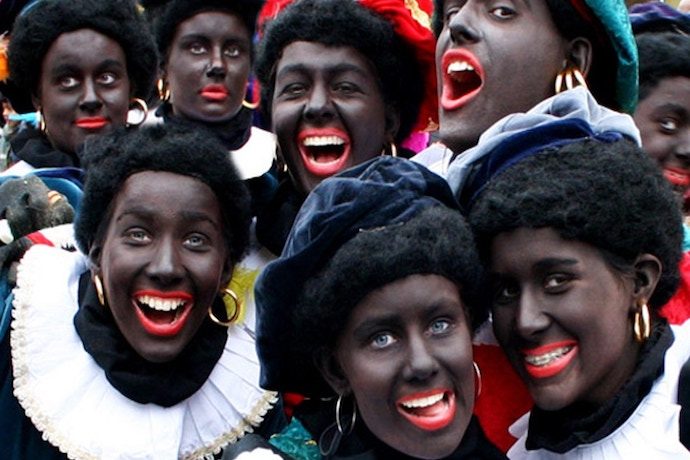In London, Black Pete travels to children’s houses in a cab with tinted windows. His boss Sinterklaas could walk the streets and be taken for either a peculiar Santa or a strange dress-up saint, but Dutch expats worry that Pete’s black face paint, red lips, gold earrings, and black curly wig might be misinterpreted. When asked about the distinctly Dutch folk character at an international summit in 2014, current prime minister Mark Rutte responded laughingly in English:
It is not green Pete or brown Pete, it is Black Pete. […] I can only say that my friends in the Dutch Antilles are very happy when they have Sinterklaas, because they don’t have to paint their faces. When I’m playing Black Pete I am – for days! – trying to get that stuff off my face.
Denying race’s relevance while affirming it in the same breath, the prime minister is emblematic of the larger Dutch public. Even knowing how people outside the Netherlands will perceive the character, most Dutch people categorically refuse to acknowledge the possibility of Black Pete being racist. Indeed, Dutch efforts to find non-offensive origins for Black Pete’s face are impressive, ranging from ‘it’s because of the chimney soot’ to ‘it’s an ancient remnant of the two ravens that were Wodan’s helpers.’ They are surpassed only by the ability to render the suggestion that the beloved blackface character is racist as both an attack on Dutchness and a threat to progress itself.
Dutch activists of color have long fought to get the majority white country to look at Black Pete and see what he is. Sinterklaas is part of a dearly beloved, long-standing folk tradition. Each winter, Sint and his Petes come to the Netherlands from Spain per steamboat, carrying candy and gifts. While Sinterklaas rides his white horse from roof to roof, the Petes climb down the chimneys to fill the shoes children have put out for that purpose. The holiday ends December 5th, when children find a coarse jute bag full of presents in an unexpected place.
Although Sinterklaas is dressed as a Catholic saint, the tradition is ostensibly a secular one. Since at least the 1940s, people of color have argued that the blackface aspect of the cherished tradition was hurtful and ruined its supposed inclusivity. However, the discussion never really gained traction until 2011, when two protesters were violently arrested for wearing shirts that said ‘Black Pete is racism’ at an event welcoming Sinterklaas’ steamboat. While a small minority is now in favor of a modified ‘soot-Pete,’ a whopping 82% of Dutch people feel that Black Pete should stay as is, forever.
Supporters of the blackface tradition have defended it tooth and nail. Two weeks ago, pro-Black Pete activists blocked a highway to prevent a van full of anti-Black Pete protesters from reaching a parade. The police did not arrest the highway obstructers, and the protest was canceled. Politicians demurred that they understood people ‘got emotional’ about children potentially seeing signs equating the beloved Black Pete character with racism. Even people agreeing that Black Pete should change often lament that the ‘Black Pete is racism’ slogan is far too polarizing and alienating.
There are myriad reasons for the Dutch to love Sinterklaas: nostalgia for childhood, the deeply felt need for authentically Dutch traditions in the face of American cultural dominance, and so on. But why would one’s tradition being called racist inspire such outrage that one cannot help but block one’s ears – or a highway – while the suggestion of one’s tradition being racist is disqualified from the get-go? It is this aspect – the intense emotional response to Black Pete being called racist – that the study of religion helps frame.
In her writing on the Danish cartoon affair, Saba Mahmood invites us to think about what constitutes moral injury in our secular world today. In an essay titled “Religious Reason and Secular Affect: An Incommensurable Divide?” Mahmood argues that the relationship Muslims have to Mohammed is predicated on an assimilative rather than a representational model, something that cannot become intelligible through the secular and crypto-Christian lens of European law. Mohammed is not a referential sign, but a moral exemplar, a way of inhabiting the world. He is, to borrow the words Faisal Devji uses to characterize Mohammed in his work on the Rushdie affair, a ‘civic ideal.’ An attack on this civic ideal constitutes a profound moral injury, because it is felt as an attack on the core of one’s being. It is a defiling of one’s aspirational self.
Though religious figures are particularly concrete and laden civic ideals in secular societies, they are not the only type imaginable. Pamela Klassen’s concept of civic secularism suggests how civic ideals may take shape outside religious traditions. Civic secularism denotes the careful remembering of those aspects of the nation’s past that sustain its current image of itself, while forgetting those histories that would undermine this self-conception. Writing of Canada, Klassen delineates how the Christian violence at the settler-state’s founding has been suppressed in favor of remembrances that support contemporary conceptions of Canada as always already harmoniously multicultural. She emphasizes that civic secularism always operates locally, clinging to some stories and tuning out others.
A key civic ideal in the Netherlands is to be ‘normaal,’ i.e. ‘ordinary.’ To be considered normaal in spite of extraordinary achievements – that is a compliment of the highest order for the Dutch. Remaining normaal is to remain true to oneself, to not get carried away. Normaal people are good people who consider their moral values self-evident, basic decency. When people bump into each other in the street, they might shout ‘doe normaal!’ (behave normaal!) at one another, as if to say: be better.
While not crystallized into one figure, being normaal is a ubiquitous civic ideal, potent enough to shape the state position on divisive issues. The center-right party that won the most recent elections did so with ‘normaal doen’ (‘behaving normaal,’ in its sense of ‘be better’) as their slogan. Last week, prime minister Rutte called an incident, where pro-Black Pete activists entered an elementary school in blackface to hand out candy and stickers about Dutch heritage, ‘not normaal.’ However, he added that he did not consider protesting at parades ‘decent,’ making the response somewhat understandable. Normaal means never getting so heated as to be disruptive. For Dutch people, ‘normaal’ is a key mode of ‘inhabiting the world, bodily and ethically,’ to return to Mahmood’s work on the relationship one has with a civic ideal as a site of potential moral injury.
To understand how ‘normaal’ interacts with whiteness, it’s important to remember that many of the socially progressive values the Netherlands is known for in North America are also very much ‘normaal’: to have solid social security in place is normaal, providing women with full access to contraceptive care is normaal, and it is most normaal of all to be tolerant and inclusive in reference to LGBTQI difference. Racism is definitely not normaal – a grave issue in the United States, to be sure, but not in the Netherlands, where race is so not ‘normaal’ that it can never become a topic at all.
The letter the prime minister published in all major newspapers as part of last year’s election campaign is a prime example of how ‘normaal’ operates in relation to racialized difference. The letter opens by stating that even though the Netherlands are doing so well, some people insist on behaving poorly, i.e. not normaal. They ‘want to throw over everything Dutch people stand for,’ he writes, giving examples that are associated with Muslims in the Netherlands (i.e. not shaking hands, ‘harassing gay people’) to argue that some people ‘abuse the freedoms and tolerance they came here for.’
Also not normaal: ‘accusing normaal Dutch people of racism.’ And whoever can’t be normaal, he states outright, had better leave. The civic secularist ideal of ‘normaal’ is predicated on a remembering of traditions of tolerance, and – the irony is painful here – of being ‘ahead’ of the rest of the world, especially the United States, in matters of social justice. The ideal of normaal is sustained by constantly forgetting histories of Dutch racism, sexism, and bigotry; a vigilant wiping away of the fog of these stories.
In a response to Talal Asad and Saba Mahmood’s reflections on blasphemy Judith Butler offers theoretical depth to the moves the prime minister makes in his letter. Butler traces how the state’s co-optation of progressive values renders those values a prerequisite of citizenship, referring to the Dutch government’s screening of prospective migrants by monitoring their responses to a video of two men kissing. Gay rights are the prime example of what ‘normaal’ fervently remembers as quintessentially Dutch.
In the prime minister’s letter, it’s very clear that the civic ideal is wielded to exclude: normaal is a civic ideal white Dutch people naturally aspire to, while Muslims must be taught and corrected in their aspiration for that civic ideal. Butler brings up the Dutch example in relation to free speech to argue for the importance of left alliances: when social justice is left to the state entirely, it becomes ossified as ‘Dutchness’ to such an extent that any criticism directed at that state is rendered un-Dutch and therefore not worthy of being heard.
Although Dutch Muslims are generally peripheral to the anti-Black Pete struggle, the move Rutte’s letter makes to align them is insightful. Rutte’s letter reinforces that all Dutch people should aspire to be ‘normaal,’ and thus aligned with a socially progressive state that looks, talks, and acts white. Simultaneously, the letter renders anyone who is not white (Muslims, or all who might have reason to accuse normaal Dutch people of racism), and is critical of the ‘normaal’ endorsed by the state, as undeserving of Dutchness and an enemy of progress.
The activists holding up ‘Black Pete is racism’ signs puncture ‘normaal.’ They are fighting for their right to tell their stories of the present and the past, and hearing these stories out would mean acknowledging that racialization does in fact affect people in the Netherlands. It would mean recognizing ‘normaal’ does not suit all Dutch people; that not all children can grow up to will themselves to see pre-Christian ravens on Wodan’s shoulder when they look at Black Pete.
A challenge to ‘normaal’ is a challenge to the moral superiority felt over Dutch Muslims and other minority groups, which is especially unwelcome in the current political climate of the Netherlands. By pushing for the blackface tradition to change, activists challenge the claim the civic secularist ideal of ‘normaal’ has to the moral good. Blasphemy: ‘normaal’ Dutch is not the high point of tolerance, justice, and progress, it’s in the eyes of all those Dutch citizens who inhabit their world by aspiring to that civic ideal. That is the moral injury that underpins the intensity of emotion in the debate.
For people who want to keep Pete Black, this sense of injury moves them to send their letters, to look away as activists are arrested for using their democratic right to protest, and to loudly lament that their freedom to be Dutch is under siege, all along legitimating the belief that they are fighting the good fight.





